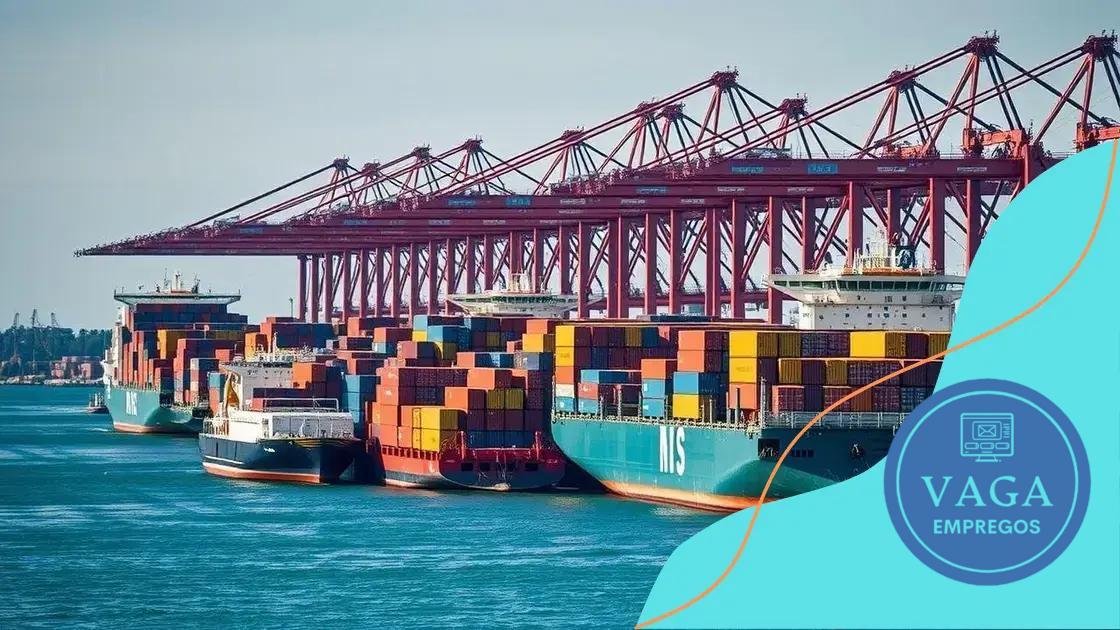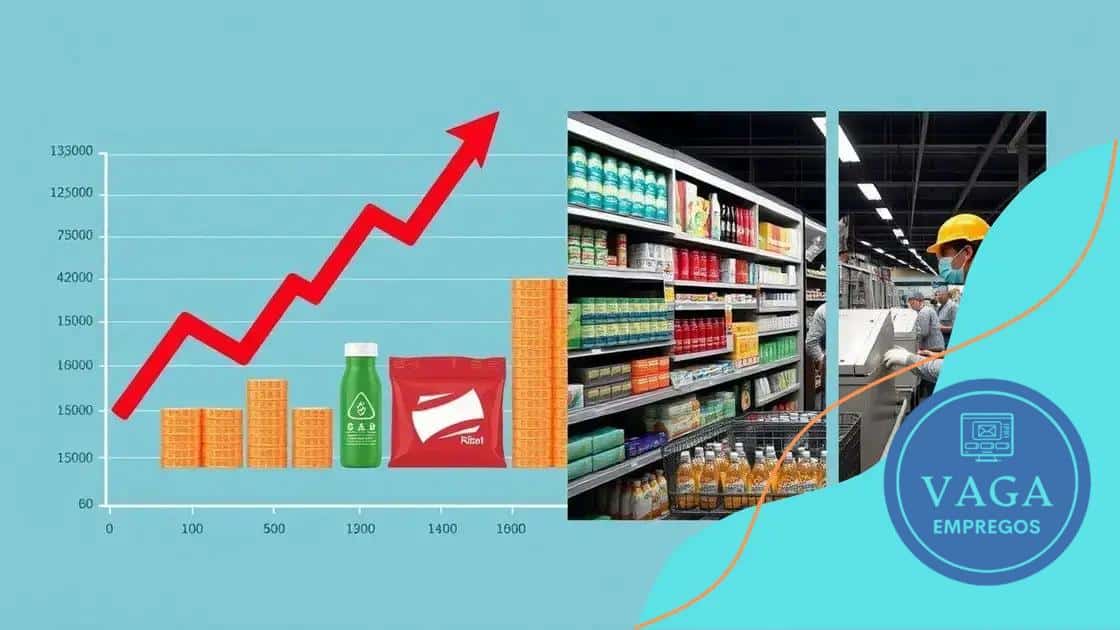Economic impact of ongoing US-China trade tensions

Advertisement
The economic impact of ongoing US-China trade tensions includes increased consumer prices, disrupted supply chains, and significant effects on various sectors such as technology and agriculture, necessitating adaptive strategies for businesses.
The economic impact of ongoing US-China trade tensions is more than just a headline; it touches almost every aspect of global trade. Have you felt fluctuations in prices or supply delays? Let’s delve into how these tensions affect economies worldwide.
Advertisement
Overview of US-China trade relations
The relationship between the United States and China has evolved significantly over the years. It is crucial to understand how trade between these two giants impacts the global economy. Trade tensions often stem from various economic policies and practices that may not align. Let’s delve into some key aspects of this relationship.
Advertisement
Historical Context
The trade relationship has a rich history. In the late 20th century, the US welcomed China into the World Trade Organization. This decision aimed to foster economic growth in both countries. However, as China’s economy grew, it began to challenge US economic dominance.
Key Factors Influencing Trade
- Tariffs: The imposition of tariffs has been a notable aspect of the trade tensions. These taxes affect the prices of goods exchanged between the two countries.
- Intellectual Property Rights: Concerns over intellectual property theft have also strained relations. The US believes that China does not adequately protect US intellectual property.
- Currency Manipulation: Currency practices have generated debates about fairness in trade. The strength or weakness of the Chinese yuan can influence export prices.
- Supply Chains: Many industries depend on supply chains that include both nations. Disruptions can lead to increased costs and delays for businesses.
Beyond these factors, the US-China trade relationship encompasses numerous elements affecting global markets. Recent years have seen fluctuating policies, making it essential for businesses to adapt. Companies often experience uncertainties due to the changing trade landscape.
Furthermore, public sentiment and political factors play a critical role in shaping trade decisions. Both governments often showcase their stances to their citizens, adding pressure to policymakers. Understanding these dynamics helps in navigating the complexities of international business.
Recognizing the impacts of US-China relations extends to other countries. Nations around the world are influenced by how these two economies interact. Thus, examining their trade relationship is vital for anyone interested in global economics.
Key economic consequences of trade tensions

The economic consequences of trade tensions between the US and China are profound and wide-reaching. These tensions create ripple effects that affect not just the two nations, but the global economy as well. Understanding these consequences is essential for anyone involved in international trade.
Impact on Consumer Prices
One significant effect of trade tensions is the increase in consumer prices. Companies often face higher costs due to tariffs. This results in companies passing on those costs to consumers, leading to more expensive goods.
- Electronics: Products like smartphones and computers may see increased prices.
- Clothing: Apparel costs are also likely to rise, hitting shoppers where it hurts.
- Food Products: Tariffs on agricultural goods can raise grocery bills.
- Home Goods: Import taxes may result in higher prices for furniture and appliances.
Besides consumer prices, another consequence is the potential slowdown in economic growth. Trade tensions often lead to uncertainty, causing businesses to hesitate in making investments. Companies may delay expansion plans or cease hiring new employees.
Effects on Specific Industries
Various industries are particularly vulnerable to changes in trade policy. For example, the automotive industry faces challenges with changing tariffs affecting the cost of parts. The technology sector is also impacted, as many components are sourced from abroad.
- Agriculture: Farmers may find it difficult to export products, affecting their income.
- Manufacturing: With increased costs, manufacturers may struggle to remain competitive.
- Retail: Retailers could see profit margins shrink due to rising costs.
- Energy: Trade policies can influence oil and gas prices during times of tension.
The implications of trade tensions also extend to employment rates. As companies tighten their budgets and become cautious, layoffs may result. This can lead to increased unemployment rates, further exacerbating economic challenges.
Moreover, the global supply chain is often disrupted. With the interconnectedness of markets, a problem in one area can have substantial effects elsewhere. Companies may struggle to obtain necessary materials, which can lead to delays in production.
Sector-specific impacts on industries
The sector-specific impacts of trade tensions between the US and China vary widely across different industries. Each sector feels the effects in unique ways, shaping the way businesses operate and influencing economic stability.
Technology Sector
The technology industry is significantly affected by the ongoing tensions. Companies that rely on imported components from China face increased costs due to tariffs. These rising expenses can lead to higher prices for consumers, ultimately affecting sales.
Automotive Industry
In the automotive sector, the situation is similarly challenging. Many manufacturers source parts from both countries. As tariffs increase, the costs of these components rise, leading to potential delays in production.
- Increased Production Costs: Automakers may have to absorb higher costs, impacting their profit margins.
- Potential Layoffs: If companies cannot keep up with rising expenses, layoffs may follow.
- Consumer Prices: Higher costs might result in more expensive vehicles, which could reduce demand.
Additionally, the agricultural industry faces significant hurdles. Tariffs on certain products can lead to decreased exports, affecting farmers’ income. This downward pressure can ignite fears of food shortages and force adjustments in pricing strategies.
Retail Market
The retail sector is also feeling the heat from these trade tensions. Store owners rely on importing products, and when tariffs increase, they often pass those costs on to customers. This results in higher prices on everyday goods.
- Clothing and Electronics: Fashion items and tech products may become more expensive.
- Profit Margins Strain: Retailers face challenges maintaining profitability due to rising source costs.
- Consumer Behavior Changes: Spending may decline as customers face higher prices.
In the manufacturing sector, trade tensions complicate the production landscape. Many manufacturers depend on a global supply chain, and disruptions can significantly delay operations. Whether related to sourcing raw materials or logistics, the challenges are profound.
Overall, assessing the sector-specific impacts reveals a complex web of challenges that businesses must navigate amidst ongoing trade tensions. Attention to these details is crucial for companies aiming to thrive in a rapidly evolving economic landscape.
Strategies for businesses navigating uncertainty

Businesses facing the challenges of trade tensions need effective strategies to navigate uncertainty. By proactively adapting their operations, companies can mitigate risks and take advantage of new opportunities.
Diversifying Supply Chains
One key strategy is to diversify supply chains. Relying heavily on any single source can be dangerous, especially during trade disputes. By sourcing materials from multiple countries, businesses can reduce their risk of disruptions.
- Find alternative suppliers: Look for suppliers in different regions.
- Local sourcing: Consider options closer to home to minimize tariffs.
- Flexible contracts: Negotiate terms that allow shifting suppliers if necessary.
Implementing these practices can help ensure a steady flow of goods and minimize costs associated with price increases.
Adjusting Pricing Strategies
Another important tactic is revisiting pricing strategies. Companies may need to adjust their prices in response to higher costs from tariffs. Understanding customer willingness to pay is critical.
- Transparent communication: Inform customers about price hikes.
- Value-added services: Offer additional services to justify higher prices.
- Promotions and discounts: Use strategies to maintain customer loyalty despite price increases.
These pricing adjustments not only help manage profit margins but also strengthen customer relationships.
Additionally, companies should invest in market research. Understanding market conditions can provide valuable insights into consumer behavior and potential areas for growth. By staying ahead of market trends, businesses can position themselves to adapt more effectively.
Networking with industry peers can also be beneficial. Sharing experiences and strategies with other businesses offers new perspectives. Support from trade associations can lead to valuable resources, helping companies navigate challenging environments together.
Finally, it is essential for companies to remain flexible. Conditions can change rapidly in the current global economy, so being ready to pivot when necessary can make all the difference.
By combining these strategic approaches, businesses can not only survive during uncertain times but also potentially thrive in the evolving marketplace.
Future predictions for global trade dynamics
The future of global trade dynamics is poised for significant changes as the impacts of ongoing trade tensions continue to unfold. Analysts and economists are closely monitoring these evolving trends to forecast what lies ahead.
Shifts in Trade Partnerships
One key prediction involves shifts in global trade partnerships. As countries reassess their alliances, new trade agreements may emerge. Countries in Asia, Europe, and even Africa may look to strengthen ties with one another as they seek stability away from US-China relations.
- Emerging Markets: Nations in Southeast Asia could see an increase in trade opportunities.
- European Union: The EU may enhance its trade agreements internally and with new partners.
- Latin America: Countries may pivot towards regional cooperation.
This realignment can change the flow of goods and services, creating new opportunities for businesses globally.
Technological Advancements and Automation
Another significant change will involve the adoption of technology and automation in trade processes. As companies strive to reduce costs and increase efficiency, we are likely to see greater investment in technology.
- Supply Chain Automation: Increased use of robotics and AI to streamline operations.
- Digital Trade Platforms: E-commerce will continue to grow, expanding market access.
- Tracking Technologies: Enhanced systems for tracking shipments will improve reliability.
These advancements will not only enhance operational efficiency but can also lead to lower prices for consumers.
Additionally, sustainability will become a key focus in future trade dynamics. As environmental concerns grow, businesses will face pressure to adopt sustainable practices. This could lead to alterations in sourcing materials and manufacturing processes to reduce carbon footprints.
Furthermore, the role of international organizations may expand. Institutions like the World Trade Organization could see a renewed focus on facilitating fair trade policies amid rising tensions. Members may prioritize collaboration to solve disputes and maintain stability in trade.
As we look ahead, understanding these future predictions can help businesses and policymakers navigate the complexities of global trade, adapting effectively to the ever-changing landscape.
In conclusion, the ongoing US-China trade tensions have far-reaching effects on the global economy. As businesses navigate this complex landscape, they must remain aware of the shifting dynamics and adapt their strategies accordingly. Future trade relationships will likely focus on new partnerships, technological advancements, and sustainable practices. Embracing these changes will be crucial for companies aiming to thrive in the evolving market.
FAQ – Frequently Asked Questions about the Economic Impact of US-China Trade Tensions
How will US-China trade tensions affect consumer prices?
These tensions can lead to increased tariffs, which may result in higher prices for goods imported from China.
What strategies can businesses use to adapt to changing trade dynamics?
Businesses can diversify their supply chains, adjust pricing strategies, and invest in technology to remain competitive.
What sectors are most affected by trade tensions?
Sectors like technology, automotive, and agriculture experience significant impacts due to reliance on imports and tariffs.
How can companies prepare for future trade relationships?
By staying informed about global market trends and being flexible in their strategies, companies can better navigate the changing landscape.





